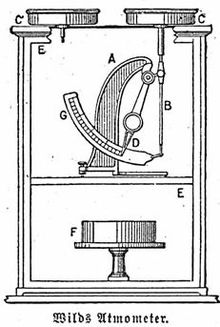Atmometer
An atmometer (Greek, also atmidometer or evaporometer ) is an evaporation meter , an instrument for measuring the amount of evaporation .
Different methods are possible to measure the evaporation. A simple way of measuring evaporation is to expose vessels with a certain amount of water to the action of the atmospheric air. The amount of evaporation can be determined from the difference between the amount of water originally present and that which has remained after a certain period of time. The difference can be determined either via the mass (via the weight ) or the volume ; from both, if the opening of the vessel is known, the amount of water that has evaporated can be calculated.
As simple as this procedure seems, when greater accuracy is required it presents some problems.
The atmometers can be divided into two classes, depending on whether the evaporation is determined by the reduction in volume or by the weight loss of the water exposed to evaporation. The first-class atmometers have the disadvantage that they are unsuitable for observation during frosty weather and are often destroyed by frost . The best-known devices of this type are designed by Adolf Mühry , Prestel , Lament, Piche and Morgenstern. This group also includes Dufour's Siccimeter, which is supposed to indicate the difference between the amount of rain and evaporation. Many constructions use evaporation, which is determined by weighing. The best known are given by Saussure and Wild, the latter of which is shown in the drawing.
Essentially, the Wild atmometer consists of a bowl-like vessel C, which can be placed on a device A similar to the postal scale . If the bowl is empty of water, the pointer D is on the zero line of the scale; but if it is loaded by poured water, the pointer on the scale is raised. During the observation, the bowl C is filled with water, placed on the pin B of the balance and the position of the pointer D is noted on the degree arc G, then removed from the balance and after the observation period (24 hours) is back on the balance and the new position of the pointer determined.
The difference between the two readings indicates either the weight of the evaporated water or its height in millimeters, depending on the nature of the graduation. The entire weighing device is enclosed in a box E, in whose compartment a small bowl with calcium chloride F is placed in order to keep the air inside it dry and to protect the metal parts of the instrument from oxidation .
As a result of the evaporation observations made so far, it emerges that, due to the influence exerted by temperature and air movement, they only insufficiently reflect the conditions of evaporation as it occurs in nature. Only larger evaporation containers or possibly evaporation meters in which the actual evaporation vessel is embedded in a larger one filled with water are suitable for this purpose.
literature
- Adolf Mühry : About a simple, more sharply measuring atmometer. In: Annals of Physics. Vol. 189, No. 6, 1861, ISSN 0003-3804 , pp. 305-308.
